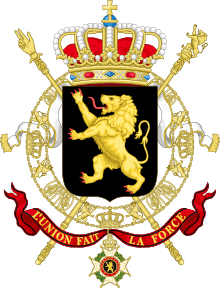Belgian general election, 1921
| | |||||||
| |||||||
| |||||||
 |
| This article is part of a series on the politics and government of Belgium |
| Constitution |
|
| Foreign relations |
General elections were held in Belgium on 20 November 1921.[1] The result was a victory for the Catholic Party, which won 76 of the 186 seats in the Chamber of Representatives.[2] Voter turnout was 91.1% in the Chamber election and 91.0% in the Senate election.[3]
Elections to the nine provincial councils were held one week later, on 27 November 1921.
A Catholic–Liberal government led by Georges Theunis was formed following the elections.
Results
Chamber of Representatives
| Party | Votes | % | Seats | +/– | |
|---|---|---|---|---|---|
| Catholic Party | 768,080 | 39.8 | 76 | +3 | |
| Belgian Labour Party | 674,204 | 34.9 | 68 | –2 | |
| Liberal Party | 349,888 | 18.1 | 33 | –1 | |
| Catholic Dissidents | 82,509 | 4.3 | 4 | – | |
| Frontpartij | 54,941 | 2.8 | 4 | –1 | |
| Leftist Dissidents | 8,944 | 0.5 | 1 | – | |
| Liberal Dissidents | 5,957 | 0.3 | |||
| Invalid/blank votes | 97,327 | – | – | – | |
| Total | 2,029,293 | 100 | 186 | 0 | |
| Source: Nohlen & Stöver | |||||
Senate
A constitutional change eased the requirements to be a candidate for the Senate. As a compensation, the number of senators elected by provincial councils was increased from 27 to 40 and a new type of senators was introduced: 20 co-opted senators. This gives a total of 153 senators.
| Party | Votes | % | Seats | +/– | |
|---|---|---|---|---|---|
| Catholic Party | 606,799 | 32.6 | 34 | –9 | |
| Belgian Labour Party | 661,168 | 35.5 | 33 | –6 | |
| Liberal Party | 362,187 | 19.4 | 18 | +7 | |
| Other parties | 233,178 | 12.5 | 8 | +8 | |
| Invalid/blank votes | 163,408 | – | – | – | |
| Total | 2,026,740 | 100 | 93 | 0 | |
| Source: Nohlen & Stöver | |||||
Constituencies
The distribution of seats among the electoral districts was as follows:[4][5]
| Province | Arrondissement(s) | Chamber | Senate |
|---|---|---|---|
| Antwerp | Antwerp | 15 | 7 |
| Mechelen | 5 | 5 | |
| Turnhout | 4 | ||
| Elected by the provincial council | 5 | ||
| Limburg | Hasselt | 3 | 4 |
| Tongeren-Maaseik | 4 | ||
| Elected by the provincial council | 3 | ||
| East Flanders | Aalst | 5 | 4 |
| Oudenaarde | 3 | ||
| Gent-Eeklo | 12 | 6 | |
| Dendermonde | 4 | 4 | |
| Sint-Niklaas | 4 | ||
| Elected by the provincial council | 5 | ||
| West Flanders | Bruges | 4 | 2 |
| Roeselare-Tielt | 5 | 3 | |
| Kortrijk | 5 | 4 | |
| Ypres | 3 | ||
| Veurne-Diksmuide-Ostend | 5 | 2 | |
| Elected by the provincial council | 4 | ||
| Brabant | Leuven | 7 | 3 |
| Brussels | 26 | 13 | |
| Nivelles | 4 | 2 | |
| Elected by the provincial council | 7 | ||
| Hainaut | Tournai-Ath | 6 | 3 |
| Charleroi | 11 | 7 | |
| Thuin | 3 | ||
| Mons | 7 | 5 | |
| Soignies | 4 | ||
| Elected by the provincial council | 6 | ||
| Liège | Huy-Waremme | 4 | 2 |
| Liège | 13 | 7 | |
| Verviers | 5 | 2 | |
| Elected by the provincial council | 4 | ||
| Luxembourg | Arlon-Marche-Bastogne | 3 | 3 |
| Neufchâteau-Virton | 3 | ||
| Elected by the provincial council | 3 | ||
| Namur | Namur | 5 | 5 |
| Dinant-Philippeville | 4 | ||
| Elected by the provincial council | 3 | ||
| Total | 186 | 93 + 40 | |
Additionally, 20 senators were co-opted.
References
- ↑ Nohlen, D & Stöver, P (2010) Elections in Europe: A data handbook, p289 ISBN 978-3-8329-5609-7
- ↑ Nohlen & Stöver, p308
- ↑ Nohlen & Stöver, p290
- ↑ List of members of the Chamber of Representatives (1921-1922)
- ↑ List of members of the Senate (1921-1922)